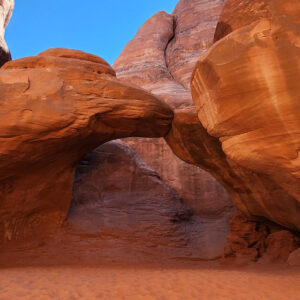Located about five miles north of Moab in southeast Utah, Arches National Park boasts more than 2,000 stone arches, sandstone fins that rise from the desert floor to tower overhead, monolith pinnacles, and balancing rocks that seem to defy gravity. If you want to get back to nature, this is the place to do it; you can’t go further back than 300 million years!
The main thing you need to know about Arches National Park is that it was once an inland sea.
“Utah was flooded with seawater that eventually receded?” you ask.
Why yes, yes it was… 29 times! What remained after the last great flood were several thousand feet of salt, sand, and mud. Over millions of years, thousands more feet of dirt and debris were added by water and wind, powerful forces that eventually sculpted a magnificent landscape.
Only seven hours from Las Vegas, the park seemed like a great place for a family getaway. As we approached the park entrance, I was excited to get my first glimpse of one of the famed arches, but my daughter Jenny said the brick structure didn’t look natural (it wasn’t on the visitor map, so I suspect she might have been right).
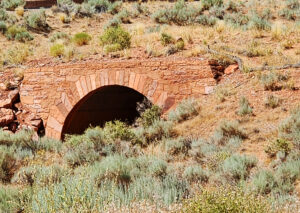
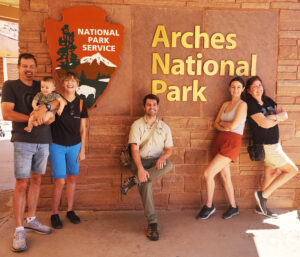
Park Avenue
After a brief stop at the visitor center to get our bearings, Beth and I headed out in search of adventure with our daughters Jenny and Sara, our son-in-law Mike, and 8-month-old grandson Bo in tow. Barely a mile down the road was Park Avenue Viewpoint, which offered a panoramic view of stone monoliths lined up like New York skyscrapers (with just as much available street parking, too).
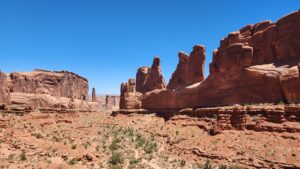

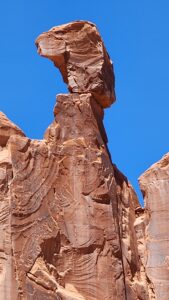
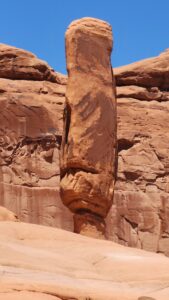
Balanced Rock
We drove another eight miles to Balanced Rock, one of the most popular features of Arches National Park. Its popularity may be due to its incredible size and orientation, but it doesn’t hurt that you can reach the base of it by walking an easy 1/4-mile paved path. The 55-foot-tall sandstone “caprock” is the size of three school buses and weighs 3,500 tons. It sits on 73 feet of “mudstone” that will eventually cause the collapse of Balanced Rock (unless some TikToker or YouTuber decides to pull a crazy stunt first).
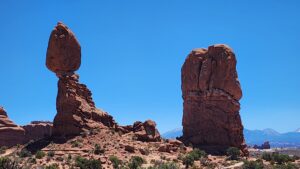

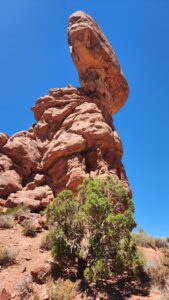
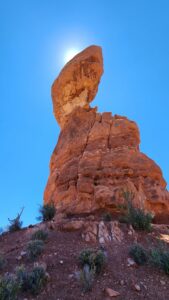
A sign by the trailhead showed a historical photo of Balanced Rock with its smaller companion – “Chip Off the Old Block” – which collapsed in the winter of 1975. Then you saw it… now, you don’t. But since social media wasn’t even a thing back then, don’t look at me!
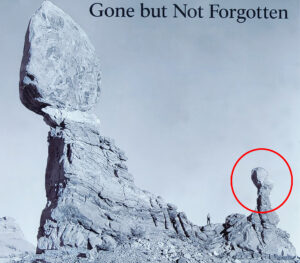
Check out this frame grab from the opening title sequence of Indiana Jones and the Last Crusade (1989). A caravan of boy scouts on horseback near the bottom of the scene shows just how massive – and impressive – Balanced Rock is.
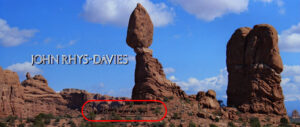
Garden of Eden
Arches National Park is big. Not 2-million-acres Yellowstone big, but large enough that you need a car and more than a day to hit the highlights. The 76,000 acres has been developed by the National Park Service with roads that take you close to most of the key natural sites without ruining them.

The Garden of Eden gave us our first chance at some easy rock climbing.
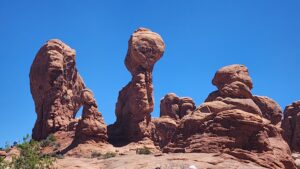
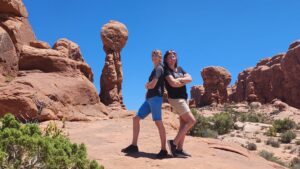
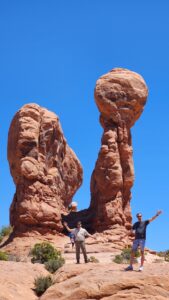
Double Arch and the March of the Elephants
After grabbing a free space in the upper parking lot (not knowing it was ridiculously far from the next attraction), Jenny and I walked down a million steps to join the others at the trailhead leading to the famed Double Arch.
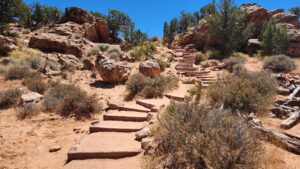
A half-mile hike brought us alongside a massive rock formation known as the March of the Elephants.
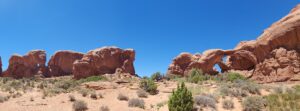
Our kids raced ahead, saw what they wanted to see, and headed back for the comfort of an air-conditioned car while Beth and I lingered to grab some photos of Double Arch. Connected at one corner, the two arches act as a natural amphitheater and magnify the sounds of birds, insects, and wind. But mostly people, who were crawling everywhere.
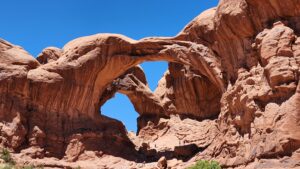
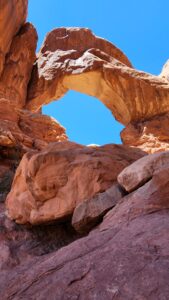
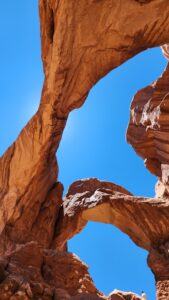
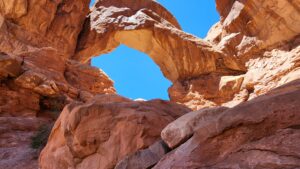
“How was Double Arch created?” you ask (if you’re not a rock hater).
It probably started as two puddles of water that swirled debris and ate away at the rock over time until they punched through. Eventually, the rock separating these two “pothole arches” also eroded away, creating the Double Arch standing today.
People on the trail were respectful of the environment and very friendly too. Luckily, I’m somewhat fluent in Australian and was able to ask a guy from down under to shoot a photo of us.
“No worries, Mate.”

The Windows
After walking a million steps back up to my car, we headed for an area called The Windows. Some arches are called “windows” when they frame a great view, and what would a national park be without a great view?
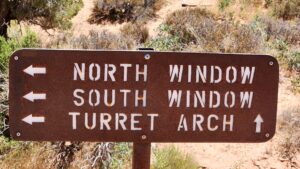
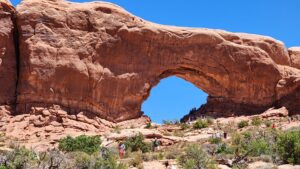
The Windows Trail is only a one-mile loop, but with an elevation change of about 100 feet under a blazing sun, I began to feel the burn in my legs, not just on the back of my neck as I made the 30-minute trek. In the distance on the left were Seagull Arch and Bicep Arch.
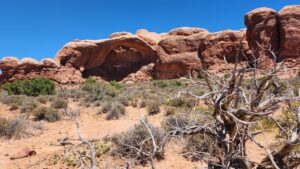
On the right was Turret Arch, tantalizingly close at only 2/10 of a mile away.
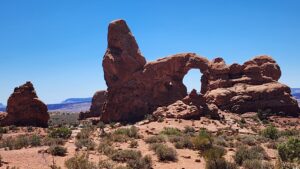
The arches on either side were interesting, but my focus was on the North Window ahead, where I could see open sky beneath a stone bridge high above ant-like visitors far ahead of me. Climbing stairs and stones to gain altitude, little by little, I reached the huge arch and the panorama beyond. Very cool, despite the heat!
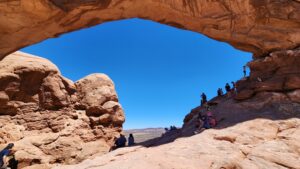
Landscape Arch
Next up was Devils Garden Trail, which leads to Landscape Arch, Double O Arch, Tunnel Arch, Pine Tree Arch, Private Arch, and Dark Angel (a free-standing 150 foot-tall sandstone pillar). The entire trail is approximately eight miles and takes 3-5 hours, with an elevation change of 286 feet. Pushing a baby stroller on a gravel path in 100-degree heat seemed like a new Ninja Warrior challenge, so we opted for a short 2-mile round tripper that limited our sightseeing to Landscape Arch.
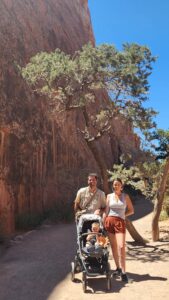
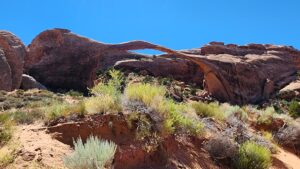
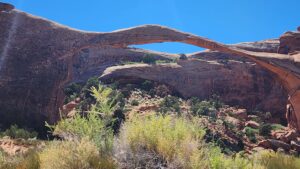

The longest arch in the park with a span of 290 feet, Landscape Arch is the fifth longest natural arch in the world (after four arches in China). One large slab fell from the arch in 1991, and two more large rockfalls happened in 1995. Since then, the trail beneath the arch has been closed.
Skyline Arch
The trek to Landscape Arch in the summer heat had pretty much worn out the group, so I continued on with Jenny as my sole hiking buddy while the rest hurried back to the condo for a dip in the pool. Even though Skyline Arch was not far from the road, Jenny was content to relax in the air-conditioned car while I hustled over for a couple photos.
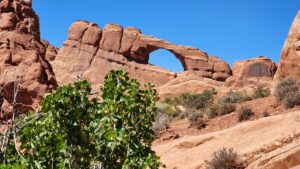

Sand Dune Arch
As we drove toward Sand Dune Arch, spectacular sandstone “fins” rose high above the desert floor. Row after row of these giants guarded a hidden gem inside, and I was eager to check it out.
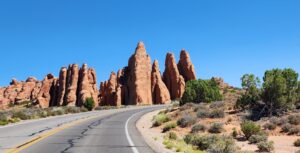
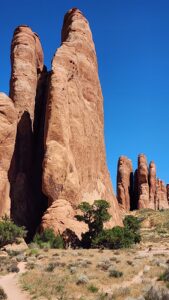
Sand Dune Arch was one of my personal favorites, perhaps because I hiked this one alone and could move at my own pace as I made my way through the maze of giant fins. Or maybe because it was different from the other arches, hidden from all but those willing to trudge through the soft red sand. There were only a handful of visitors when I arrived, and it didn’t take long for me to have the majestic site to myself.
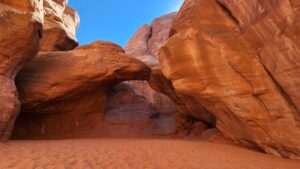
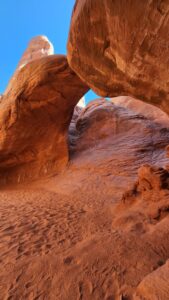
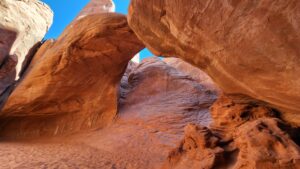
Jenny elected to experience Sand Dune Arch as only a twentysomething can – by looking at photos on my phone after I returned from the 30-minute slog through thick sand.
Fiery Furnace
Refreshed by an hour in air conditioning, Jenny was ready to hit the trails with me again as we reached the Fiery Furnace. As we didn’t have the necessary permit, we were only able to hike down to the viewing platform, but that was fine with us since the day was getting short and the shadows long.
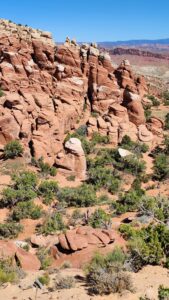
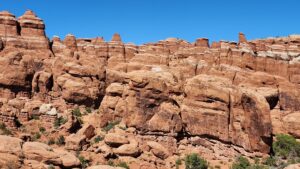
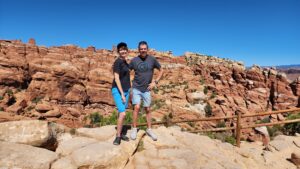

Named for its reddish color at sunset and a nod to chapter 3 of the biblical Book of Daniel, the Fiery Furnace is a maze of narrow passages and tall rock columns. Featured formations inside include Walk Through Arch, Crawl Through Arch, Skull Arch, Kissing Turtles Arch, and Surprise Arch. The only way to see them is to purchase the 2-mile, 3-hour ranger-guided tour or take a self-guided walk after watching a mandatory orientation video about minimizing human impact on the delicate environment.
No question I’ll be back with more time, energy, and pre-planning to obtain the hiking permit, purchase the tour, and experience the Furnace properly someday.
Delicate Arch
With the sun dipping low, we had time for one last attraction… the one we’d been seeing on license plates ever since we crossed the state line.
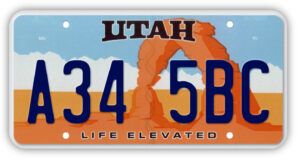
Delicate Arch, a 52-foot-tall freestanding natural arch, is the most widely recognized landmark in Arches National Park and throughout the state. Besides being featured on Utah license plates, it was also memorialized in postage stamps celebrating the centennial anniversaries of Utah’s statehood in 1996 and the National Park Service in 2016.
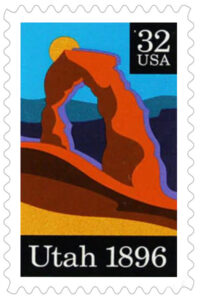
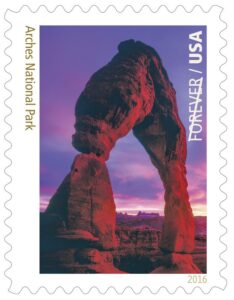
Another historical tidbit… the torch relay for the 2002 Winter Olympics passed through the arch, though I can’t imagine the top of a rocky hillside was anywhere near a direct path to Salt Lake City.
Delicate Arch was the last stop on our whirlwind day trip. It can be admired from a Lower Viewing Area only 200 feet from the parking lot or from an Upper Viewing Area half a mile away and 171 feet higher. I’ll let you guess which viewing area we went to.
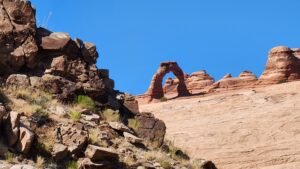
Delicate Arch is also on my list of “Take 2” experiences when I return someday.
The Three Gossips
On our drive toward the park exit, we happened upon one more noteworthy rock formation: The Three Gossips, named for shapes resembling three people talking amongst themselves.
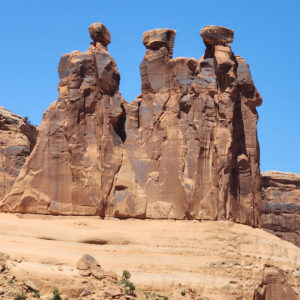
We’d come full circle, looking up at monolithic rocks that had also graced the silver screen at the start of Indiana Jones and the Last Crusade. By now, I had a much better appreciation of the natural wonders that had attracted Steven Spielberg and his location manager. I was also pleased to discover that the Gossips hadn’t aged a day in 33 years!
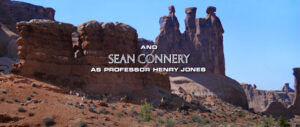
I walked a lot and saw a lot in one fantastic day, but I barely scratched the surface of the park. With more than 1,900 arches left to see, I might be coming back every year for the next 20 years.


